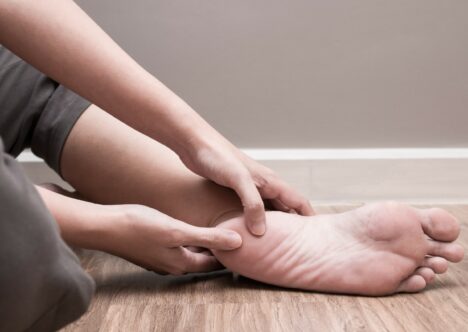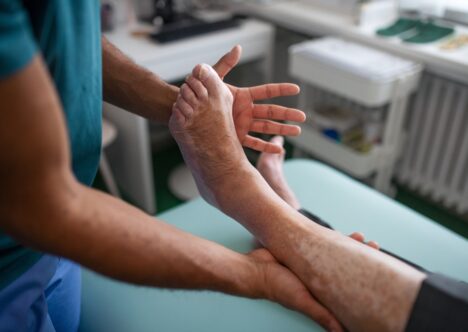Use our convenient online scheduler to book an appointment now.

Are you experiencing foot pain and looking for answers? Whether you’re dealing with heel, arch, or toe pain, our detailed foot pain charts provide valuable insights into what could be causing your discomfort. From common issues like plantar fasciitis to specific conditions like Achilles tendonitis, our charts break it down into an easy-to-understand format that provides potential explanations for your situation.
Use These Foot Pain Charts To See What May Be Causing Your Pain
Outer Side Foot Pain

A. Peroneal Tendinopathy, Longitudinal Tear Peroneal Tendon, Lateral Ligament Sprain
Injuries to the peroneal tendons in your foot often occur when the tendons tear due to other ankle injuries, such as a lateral ligament sprain (or sprained ankle). A torn peroneal tendon may cause pain on the outside of your ankle, and your foot may feel unstable.
B. Mid-Portion Achilles Tendinopathy, Achilles Paratenonitis, Plantaris Tendinopathy, Posterior Ankle Impingement (Os Trigonum & Steeda Process), Achilles Tendonitis
These are several conditions associated with inflammation of the Achilles tendon, which connects the calf muscles to the heel bone.
C. Insertional Achilles Tendinopathy, Calcaneal Apophysitis, Retrocalcaneal Bursitis, Calcaneus Fracture
The calcaneus, or bone forming the heel, can be the source of pain for several reasons: inflammation of the Achilles tendon, where it attaches to the heel bone, inflammation of the heel’s growth plate, or a fracture of the heel bone itself.
D. Lateral Malleolus Fracture, Lateral Gutter Impingement
A lateral malleolus fracture is an ankle fracture that occurs when the fibula breaks just above the ankle joint. It is the most common type of ankle fracture and may happen when the foot rolls or twists. Lateral gutter impingement happens when soft tissue becomes trapped in the gutter of the ankle.
E. Sinus Tarsi Syndrome, Lateral Ligament Sprain, Ankle Sprain
The subtalar joint enables the foot to move from side to side and is located below the ankle. Sinus tarsi syndrome is a painful joint swelling that can occur after an acute ankle sprain.
F. Tailor’s Bunion, Capsulitis
A Tailor’s bunion is an area of inflammation around the small toe, probably caused by wearing narrow, too-tight shoes, while capsulitis is an inflammation of a joint that generally happens to the second toe (but can occur elsewhere in the body).
G. 5th Metatarsal Fracture, Iselin’s Disease, Peroneal Tendon Enthesopathy
Iselin’s disease is a type of growing pain that affects children’s feet at the outside border of the foot at the base of the fifth metatarsal bone. Swelling or pain on the outside of the foot can be a sign of peroneal tendon enthesopathy.
H. Cuboid Irritation, Cuboid Fracture, Os Peroneum
The cuboid bone is one of the seven tarsal bones in the foot and plays a role in maintaining the foot’s arch. When it becomes irritated or fractured, it can lead to discomfort and limited mobility. The Os peroneum is a small bone located near the cuboid bone that, when irritated or inflamed, can cause pain on the outer side of the foot.
I. Bifurcate Ligament Sprain, Anterior Process Calcaneus Fracture, Tarsal Coalition Syndrome
A Bifurcate ligament sprain is an injury to the ligament connecting the calcaneus (heel bone) to the navicular and cuboid bones in the foot. This ligament can be sprained or injured by sudden twisting or rolling of the foot.
Anterior process calcaneus fracture is a fracture of the front part of the heel bone, often caused by direct trauma or overuse.
Tarsal coalition syndrome is a condition in which two or more bones in the foot are abnormally connected, usually due to a failure of normal joint development during childhood. This can cause pain, stiffness, and a limited range of motion.
Inner Side Foot Pain

A. Deltoid Ligament Sprain, Medial Malleolus Bursitis, Impingement syndrome
A Deltoid ligament sprain is an injury to the ligaments on the inner side of the ankle. It typically occurs when the foot is forcefully twisted, or excessive stress is placed on the ligaments.
Medial malleolus bursitis is inflammation of the bursa located on the inner side of the ankle caused by repetitive movements, overuse, or direct trauma.
Impingement syndrome refers to the compression of soft tissues between bones in the ankle joint, leading to pain and limited range of motion.
B. Midfoot Arthritis, LisFranc Sprain
Midfoot arthritis is a degenerative condition that affects the joints in the middle of the foot, leading to pain, stiffness, and swelling.
LisFranc sprain is an injury to the midfoot where the metatarsal bones connect to the tarsal bones. It is often caused by a sudden twisting or impact on the foot. This can result in severe pain, swelling, and difficulty walking.
C. Tennis Toe, Skiers Toe, Hallux Joint Arthritis
Tennis toe, also known as subungual hematoma, is a condition where blood collects under the toenail due to repetitive trauma or pressure on the toe and causes pain and nail discoloration.
Skiers toe, also known as frostbite toe, is a condition in which the toes are exposed to cold temperatures for an extended period, leading to pain, numbness, and discoloration of the skin.
Hallux joint arthritis is degeneration of the joint at the base of the big toe, which can cause pain, stiffness, and swelling.
D. Bunion Pain, Turf Toe, Gout, Hallux Rigidus
Bunion pain is a common condition characterized by a bony bump that forms on the joint at the base of the big toe.
Turf toe is a sprain of the ligaments around the big toe joint, often caused by hyperextension of the toe.
Gout is a form of arthritis caused by a buildup of uric acid crystals in the joints, often affecting the big toe. This can cause sudden and severe pain, swelling, and redness in the affected joint.
Hallux Rigidus is a condition with limited movement and stiffness in the big toe joint, often due to arthritis or injury.
E. Accessory Navicular, Navicular Fracture, Kohler’s Disease, Mid-Portion Plantar Fasciitis, Flatfoot Deformity Accessory
An accessory navicular is an extra piece of bone or cartilage located on the foot’s inner side near the navicular bone. This can cause pain and discomfort with pressure or activity.
A navicular fracture is a break in the navicular bone that can occur from trauma or overuse.
Kohler’s disease is a rare condition where the navicular bone in the foot loses its blood supply, leading to pain, stiffness, and difficulty walking.
Mid-portion plantar fasciitis is inflammation of the plantar fascia in the middle of the foot. It causes heel or arch pain that worsens with activity.
Flatfoot deformity is a condition where the arch of the foot collapses, leading to pain, swelling, and difficulty walking.
F. Calcaneus Stress Fracture, Heel Fat Pad Atrophy
A calcaneus stress fracture is a hairline crack in the heel bone, often caused by overuse or repetitive stress.
Heel fat pad atrophy is when the fat pad on the bottom of the heel thins out, leading to pain and discomfort when walking or standing for long periods.
G. Baxter’s Nerve Entrapment
Baxter’s nerve entrapment is compression or irritation of the nerve that supplies sensation to the heel and ankle. This can lead to pain, tingling, and numbness in the heel and bottom of the foot.
H. Posterior Tibial Tendonitis, FHL Tendonitis
Posterior tibial tendonitis is inflammation of the tendon that supports the arch of the foot, causing pain and swelling on the inner side of the ankle.
FHL tendonitis is inflammation of the flexor hallucis longus tendon, which helps to flex the big toe. This can cause pain and stiffness in the back of the ankle and foot.
I. Medial Malleolus Fracture
A Medial malleolus fracture is a break in the bony projection on the inner side of the ankle resulting from trauma or twisting. It causes pain, swelling, and difficulty bearing weight.
Front Foot Pain

A. Extensor Tendonitis
Extensor tendonitis is inflammation of the tendons on the top of the foot, causing pain and stiffness in the area. It can lead to difficulty walking or moving the foot.
B. Claw Toe
Claw toe refers to a condition in which the last two joints of a toe become bent in a claw-like shape, reducing flexibility.
C. Tib. Anterior Tendonitis
Anterior tibialis tendonitis is a condition involving injury to the anterior tibialis tendon, which is located at the front of the ankle where it meets the foot.
D. Ankle Sprain
Ankle sprains are a common injury that occurs when the ligaments in the ankle are stretched or torn.
E. Posterior Tibial Tendonitis
This condition causes pain on the inner side of the ankle due to inflammation of the tendon that supports the foot’s arch, leading to difficulty walking or standing for long periods.
F. Stress Fracture
Stress fractures are small cracks in the bone that can result from repetitive stress or overuse, leading to pain and discomfort.
G. Mallet Toe, Hammer Toe
Mallet toe and hammer toe are deformities that cause toes to bend downward or curl under.
H. Shin Splints
Shin splints are characterized by pain along the shinbone, typically caused by overuse or repetitive stress on the shin muscles.
Back Foot Pain

A. Heel Spur, Fat Pad Atrophy
A heel spur is a bony growth that forms on the heel bone, often causing pain and discomfort when walking or standing.
Fat pad atrophy refers to the thinning of the fat pad on the bottom of the foot, leading to increased pressure and pain in the affected area.
B. Plantar Fasciitis
Plantar fasciitis is a common cause of heel pain that occurs when the tissue that connects the heel bone to the toes becomes inflamed.
C. Tarsal Tunnel Syndrome, Midsubstance Plantar Fasciitis, Plantar Fibroma
Plantar fibromas are growths on the foot’s arch that are not associated with cancer but cause pain and discomfort.
D. Achilles Tendonitis
Achilles tendonitis is an injury to the Achilles tendon, which connects the calf muscles to the heel bone. This condition can result from overuse or sudden increases in physical activity, causing pain and stiffness in the back of the heel or calf.
E. Heel Spur, Bursitis, Os Trigonum
A heel spur is a bony growth on the underside of the heel bone that can cause pain and discomfort, especially when walking or standing.
Bursitis is inflammation of the fluid-filled sacs (bursae) that cushion and protect the joints, leading to pain and swelling.
Os trigonum, a congenital syndrome, is an extra bone behind the ankle bone that can cause pain to develop at the back of the ankle from trauma or repetitive stress.
F. Tarsal Coalition
Tarsal coalition is a condition where two or more bones in the foot are abnormally connected, leading to a limited range of motion and pain.
G. Bunionette, Calluses
A bunionette, also known as a tailor’s bunion, is a bony bump that forms on the joint at the base of the pinky toe.
Calluses are thickened areas of skin that develop on the feet as a result of repeated friction or pressure.
H. Plantar Fibromatosis
Plantar fibromatosis is a condition characterized by the growth of benign tumors on the plantar fascia, the thick band of tissue that runs along the bottom of the foot. These tumors can cause pain, stiffness, and thickening of the affected area.
I. Morton’s Neuroma
Morton’s neuroma is a painful condition that affects the nerves between the toes, most commonly between the third and fourth toes. It can cause sharp, burning pain in the ball of the foot or toes, as well as numbness or tingling.
Take the Next Step To Stop Your Foot Pain With TCO
As you can see from our foot pain charts, many conditions could be causing you pain or discomfort. Don’t let it keep you from living life to your fullest. Our Town Center Orthopaedic foot and ankle experts can diagnose your condition and provide treatment, support, and personalized care to get you back on your feet—fast. Our offices are conveniently located in Northern Virginia, so there’s sure to be a location nearby where we can see you and help you feel better, move better, and be better soon.
Call (703) 435-6604 or use our online scheduler to schedule an appointment today.
Join our Mailing List
TCO provides patients with orthopedic problems the trusted resources and patient-centered advice they need to “Feel Better. Move Better. Be Better.”
© 2024 Town Center Orthopaedics | All Rights Reserved


